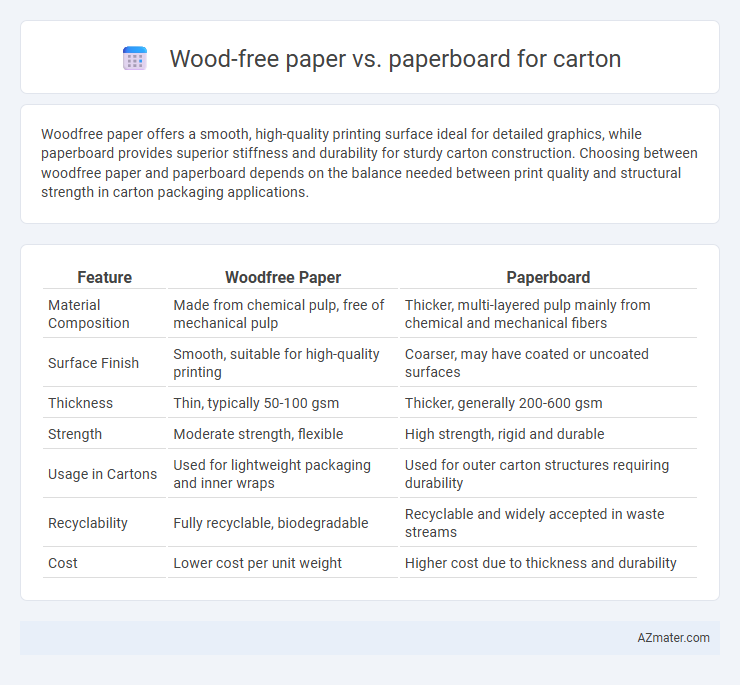Woodfree paper offers a smooth, high-quality printing surface ideal for detailed graphics, while paperboard provides superior stiffness and durability for sturdy carton construction. Choosing between woodfree paper and paperboard depends on the balance needed between print quality and structural strength in carton packaging applications.
Table of Comparison
| Feature | Woodfree Paper | Paperboard |
|---|---|---|
| Material Composition | Made from chemical pulp, free of mechanical pulp | Thicker, multi-layered pulp mainly from chemical and mechanical fibers |
| Surface Finish | Smooth, suitable for high-quality printing | Coarser, may have coated or uncoated surfaces |
| Thickness | Thin, typically 50-100 gsm | Thicker, generally 200-600 gsm |
| Strength | Moderate strength, flexible | High strength, rigid and durable |
| Usage in Cartons | Used for lightweight packaging and inner wraps | Used for outer carton structures requiring durability |
| Recyclability | Fully recyclable, biodegradable | Recyclable and widely accepted in waste streams |
| Cost | Lower cost per unit weight | Higher cost due to thickness and durability |
Understanding Woodfree Paper: Key Features
Woodfree paper, primarily composed of chemical pulp with minimal mechanical pulp, exhibits superior brightness, smoothness, and durability compared to conventional paperboard used for cartons. Its lower lignin content enhances print quality and prevents yellowing, making it ideal for high-end packaging requiring clear graphics. The absence of wood fibers results in enhanced surface properties, providing eco-friendly options for sustainable carton production.
Overview of Paperboard: Characteristics and Uses
Paperboard is a thick, durable material made from multiple layers of pulp fibers, offering superior stiffness and strength compared to woodfree paper. It is commonly used in packaging applications such as cartons, folding boxes, and rigid packaging due to its excellent printability and ability to protect contents. Paperboard's versatility includes options like coated, uncoated, and recycled types, making it ideal for various industries including food, cosmetics, and pharmaceuticals.
Production Processes: Woodfree Paper vs Paperboard
Woodfree paper production involves chemical pulping processes that remove lignin, resulting in a smoother and brighter surface ideal for high-quality printing applications. Paperboard manufacturing uses mechanical and chemical pulps combined through multi-layer layering techniques to achieve thickness and rigidity suitable for packaging and carton structures. Enhanced wet pressing and calendering in paperboard production improve stiffness and durability, distinguishing it from the lighter, less dense woodfree paper.
Strength and Durability Comparison
Woodfree paper exhibits a smooth texture with moderate strength, making it suitable for lightweight packaging but less resistant to tearing and moisture. Paperboard, typically thicker and denser, offers superior strength and durability, ideal for cartons requiring robust protection during shipping and handling. The fiber composition and thickness of paperboard provide enhanced rigidity and impact resistance compared to woodfree paper.
Printing Quality: Which Material Performs Better?
Woodfree paper offers superior printing quality for carton packaging due to its smooth, virus-free surface that ensures sharp, vibrant image reproduction and consistent ink absorption. Paperboard, while thicker and more rigid for structural strength, may present challenges in achieving fine detail and color accuracy because of its relatively porous and uneven surface texture. Choosing woodfree paper enhances the visual appeal of carton prints, making it the preferred material for high-definition, color-critical packaging applications.
Environmental Impact and Sustainability
Woodfree paper, typically made from chemical pulp with fewer lignin residues, offers higher recyclability and lower environmental impact compared to paperboard, which is often heavier and requires more resources for production and disposal. Paperboard, used for cartons due to its rigidity and durability, generally involves more water and energy consumption, increasing its carbon footprint and slowing its biodegradation rate. Sustainable packaging trends favor woodfree paper for its lower greenhouse gas emissions, reduced deforestation risk, and compatibility with circular economy principles in carton manufacturing.
Cost Considerations: Woodfree Paper vs Paperboard
Woodfree paper generally offers lower production costs compared to paperboard, making it a budget-friendly option for lightweight packaging. Paperboard, with its thicker structure and higher durability, incurs higher raw material and manufacturing expenses but provides superior protection for heavier products. Choosing between woodfree paper and paperboard requires balancing cost constraints with the packaging strength and application needs.
Applications in Carton Packaging
Woodfree paper offers a smooth surface ideal for high-quality printing, making it suitable for retail cartons and folding cartons where brand visibility is crucial. Paperboard, with its thicker and more rigid structure, provides superior strength and durability, commonly used for heavier or protective packaging such as food cartons and pharmaceutical boxes. Both materials enhance carton packaging functionality, with woodfree paper favoring aesthetic appeal and paperboard ensuring robust product protection.
Customization and Design Flexibility
Woodfree paper offers superior customization and design flexibility due to its smooth, bright surface that enhances print quality for intricate graphics and fine text, making it ideal for premium carton packaging. Paperboard, while thicker and more rigid, provides a sturdy base suited for structural customization and shaping but is less optimal for detailed graphic designs. Choosing between woodfree paper and paperboard depends on whether priority lies in high-resolution visual appeal or in robust, form-retaining carton construction.
Choosing the Right Material for Your Carton Needs
Woodfree paper offers a smooth, printable surface ideal for high-quality graphic reproduction, making it suitable for cartons requiring vivid branding and detailed design. Paperboard provides superior rigidity and durability, essential for protecting heavier products and ensuring structural integrity during shipping and handling. Selecting the right material depends on balancing print clarity with strength requirements, product weight, and your carton's intended use to optimize performance and presentation.

Infographic: Woodfree paper vs Paperboard for Carton
 azmater.com
azmater.com